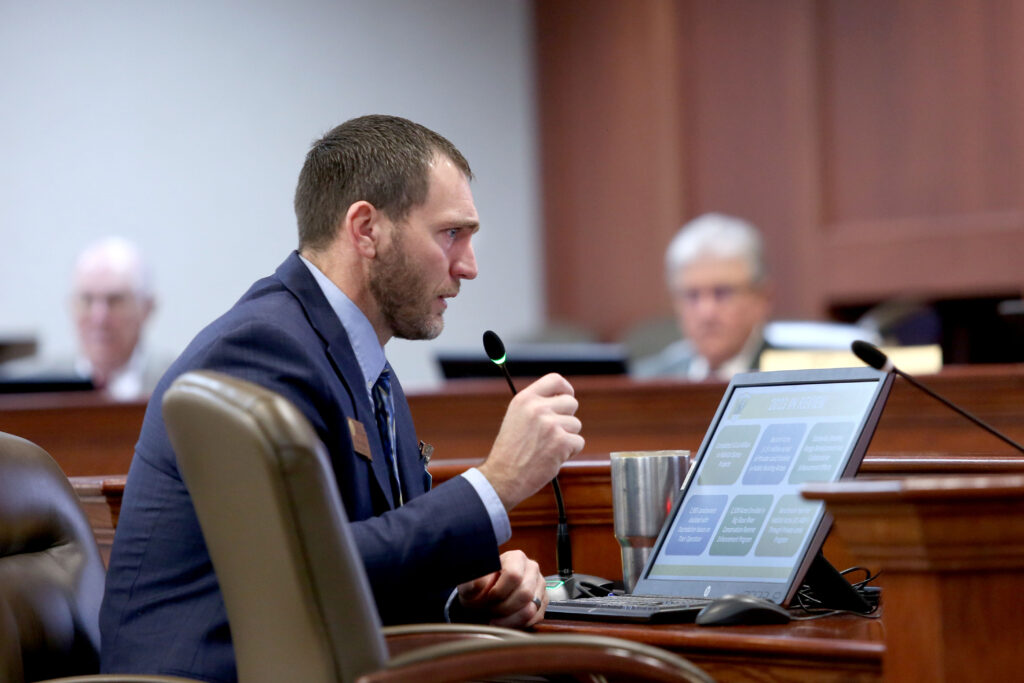
South Dakota Game, Fish and Parks Secretary Kevin Robling testifies to the state House Committee on Agriculture and Natural Resources on Jan. 16, 2024. (Makenzie Huber/South Dakota Searchlight)
Joshua Haiar, South Dakota Searchlight – A state official said Tuesday there is no data to show that a predator trapping program has increased the state’s pheasant population.
Game, Fish and Parks Secretary Kevin Robling presented information about the program to the House Agriculture and Natural Resources Committee and fielded questions from committee members during a hearing at the Capitol in Pierre.
Rep. Kadyn Wittman, D-Sioux Falls, asked, “Do we have any data that this has increased the pheasant population in South Dakota since 2019?”
“No, we do not,” Robling replied.
He said “there are so many variables” that impact pheasants, including weather and habitat quality; therefore, conducting a study controlled for one variable is difficult. He added that research elsewhere shows the state’s approach “can influence and enhance nest success.”
The Nest Predator Bounty Program is designed to control populations of animals including raccoons, skunks, badgers, opossums and red foxes. They prey on ground-nesting birds such as pheasants and ducks, which are important to South Dakota’s hunting industry. The program pays trappers $10 for each tail they turn in from a nest predator.
Robling said the program “has been really successful.” Forty-six percent of participants are under 18 (motivated by various prizes offered by the department), and over 240,000 tails have been submitted since the program’s inception five years ago.
“This is a fun activity for kids, and it contributes back to wildlife management,” Robling said.
Critics have argued that without solid data, it’s challenging to justify the program’s cost and potential ecological impact.
After her exchange with Robling, Wittman said, “I would love to see data.” She referenced the 2019 termination of the state’s roadside brood count, which involved GF&P staff driving the same rural routes every year to count broods or hens and extrapolate a total pheasant population estimate.
“I wonder if there’s any appetite to have a conversation about bringing that back,” Wittman said, “so that we can see the actual impact that this is having on our pheasant population.”
The state ended the brood count “to ensure that South Dakota is not unintentionally deterring hunters from coming to our state based on the media headlines reporting of low bird numbers,” according to a departmental marketing plan.
Robling said “a brood count will not quantify the impacts of a nest predator bounty program,” referring back to his previous point about controlling for variables.
“Bringing back a brood survey will not get you to the answer you are looking for,” he said.
Later, Rep. Marty Overweg, R-New Holland, asked Robling to “break down for us” how many of the state’s harvested pheasants are birds raised in the wild, versus raised on a farm, like chickens. Those pheasants are later released onto private land or onto a shooting preserve.
“How many were wild and how many were pen-raised?” Overweg asked.
Robling said, “I can’t give you an exact number because I don’t have it.” But he added that 500,000 pheasants were harvested on shooting preserves last year. About 1.2 million total pheasants were harvested in 2023.
Habitat and access
On other topics Tuesday, Robling said the state has a record number of public hunting acres available. He highlighted the Conservation Reserve Enhancement Program (CREP).
The program leverages the U.S. Department of Agriculture’s Conservation Reserve Program (CRP), which pays landowners for habitat conservation through multi-year contracts. GF&P then offers an additional incentive, the “Enhancement” part, so it can improve habitat quality and guarantee the public access in particular areas of the state.
Robling said the department has 81,838 of those acres enrolled in its James River CREP initiative and has reached 2,509 acres in its new Big Sioux River initiative.
“With this program, we’re going to be offering some unbelievable habitat for folks to really utilize up and down the I-29 corridor,” Robling said.
Zebra mussels
Robling showed lawmakers a map illustrating how the aquatic invasive species called zebra mussels rapidly spread throughout the region.
“It’s not just us,” he said. “It’s all states.”
Robling noted boat inspectors found a 98% compliance rate regarding the department’s preventative messaging, encouraging all boaters to “clean, drain, dry, every single time.”
Assisting ranchers
Robling said last year’s “tough winter” put pressure on the state’s deer population, pushing them onto farmers’ cropland where they caused a 358% increase in crop damages. He said the department took 655 requests last year from landowners to remove deer from their property, as well as install the infrastructure to keep them off, like fencing.
“We’re trying to provide those producers a service,” he said.
To assist ranchers during the calving season, Robling said the department’s 28 full-time trappers helped kill 11,599 coyotes. That’s the most since 2012.
